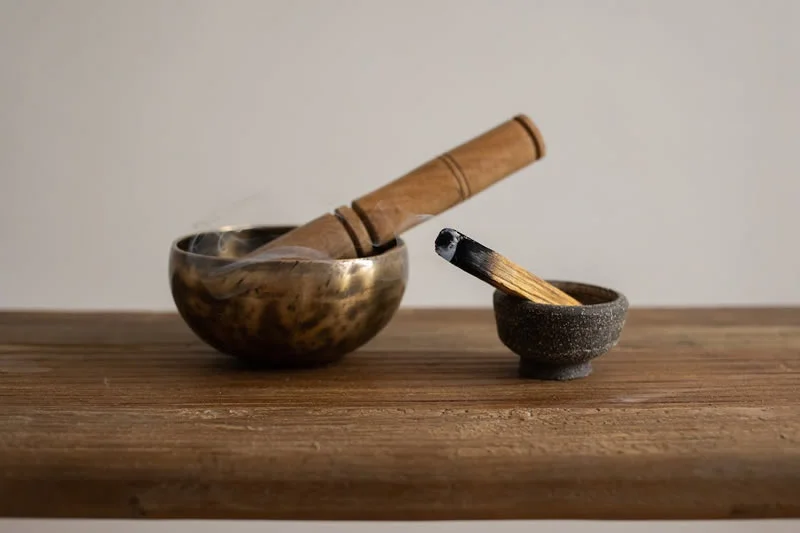The singing bowl tones are an ancient and beautiful sound that can be used for healing and relaxation. They are a powerful tool for reducing stress and promoting inner peace.
If you’re curious about the healing power of sound, you’ll want to learn more about singing bowl tones and how they can benefit your life. Keep reading to find out how to use them to your advantage!

Key Takeaways
- There are various types of singing bowls, including Thadobati, Jambati, Ultabati, Naga, Mani, Remuna, and Lingam.
- Each type of singing bowl offers a unique tone and vibration due to its size, shape, and materials used.
- In addition to metal singing bowls, crystal singing bowls with tuning forks also produce unique tones and vibrations that are gaining popularity in sound healing and meditation practices.
Content
Thadobati Singing Bowl Tones
Thadobati singing bowls have high walls, flat bottoms, and straight sides, and they are known for their deep and resonant sound.
These bowls are the most popular and unique singing bowls available in the market. The tone of Thadobati bowls can range over four octaves, from the bottom of the 3rd octave to the 6th octave.
They are popular among sound healers due to their deep and grounding tones that can produce a calming effect on the mind and body.
These types of bowls are versatile and can be used for a wide range of meditation and sound healing practices.
They can produce low frequencies that help reduce stress and anxiety and promote relaxation. Thadobati bowls also have a subtle and gentle quality that can help balance the chakras and remove blockages from the body’s energy channels.
Thadobati bowls are handcrafted using a special technique that involves heating and hammering the bowl’s metal to create the desired shape and sound.
They are made of a mixture of metals, typically seven, and can have intricate etchings and designs on the surface.
Jambati Singing Bowl Tones
Jambati singing bowls have curved walls, flat bottoms, and inward-facing lips, making them one of the heaviest and most unique types of singing bowls.
These bowls are known for their classical etching lines and can produce hauntingly beautiful sounds. Jambati bowls generally play in the 2nd or 3rd-octave range but can produce a range of four different octaves.
Due to their weight, Jambati bowls require multiple craftsmen to forge and are considered a rare type of singing bowl.
The sound of Jambati bowls is rich and complex, with a deep, resonant tone that can evoke feelings of peace and tranquility.
The haunting quality of their sound makes them perfect for creating a meditative or relaxing atmosphere. Jambati bowls are also often used in sound healing, as their unique vibrations can help harmonize the body and mind.
Ultabati Singing Bowl Tones

Ultabati bowls are large and heavy bowls that can produce the lowest two octaves and are known for creating the OM sound, which holds spiritual significance in Buddhist practice.
These bowls have a similar shape to Jambati bowls but have a curved side under the rim. Ultabati bowls are easy to play and produce a resonant and soothing sound.
The low frequency of the sound can stimulate a deep sense of relaxation and calmness. Ultabati bowls are often used in sound recovery sessions to reduce tension, and pressure, and promote general well-being.
The making of Ultabati bowls is a complex process that involves several steps. The craftsmen use specific alloys that are perfectly blended to create a unique sound.
The bowls are then hammered and shaped by hand, creating a dense and thick structure that contributes to the deep resonance of the sound.
Naga Singing Bowl Tones
Naga bowls, also known as pedestal bowls, have a chalice-like appearance and a wide range of tones, making them rare finds today.
These unique sound bowls have rounded bottoms and a wide, flared mouth. Their design makes them perfect for holding and producing a variety of tones.
Naga instrument can produce a range of tones from the third to the sixth octave. They were traditionally used as offering bowls in religious ceremonies, and are now highly prized by collectors due to their rarity.
When played, they emit a deep and full sound that can help bring balance and harmony to the mind and body.
Mani Singing Bowl Tones
Mani bowls have an inward-facing lip, flat bottom, and thick walls, producing a very high tone that was traditionally used for ceremonial and sacred purposes. T
These small to medium-sized bowls are sometimes referred to as mudra bowls and are made from a combination of metals, including gold, silver, copper, and iron.
They are often used for chanting, meditation, and sound healing.
The high tone of the Mani bowl is perfect for ceremonial purposes. They are used to create a sacred atmosphere for chanting and prayer.
When struck or played, the Mani bowl produces a beautiful and clear sound that resonates deeply within the body, aiding in relaxation and spiritual healing.
Mani bowls are also used in Tibetan rituals and are considered sacred objects.
They are used to invoke the blessings of the gods and to purify one’s mind and body.
The high tone of the bowl is believed to help align the chakras and promote inner peace and harmony.
Crystal Singing Bowl Tones
In addition to traditional metal singing bowls, crystal singing bowls offer different tones and vibrations, gaining popularity among sound healers and meditation practitioners.
They’re made from pure quartz crystal and are available in various sizes and tones.
The bowls produce a clear, pure sound that is said to resonate with the body’s energy centers and promote healing.
Crystal bowls are believed to have a higher frequency than metal bowls and can create a more powerful and intense experience during sound healing sessions.
They are also known for their longevity, as they do not corrode or rust like metal bowls do.
These bowls are a great option for those who prefer a lighter, higher tone compared to the deeper tones produced by metal bowls.
They are also a good choice for those who are sensitive to metals or prefer to work with natural materials.
Conclusion
In conclusion, there is a wide variety of singing bowls available in the market today, each with its own unique sound and purpose.
Thadobati, Jambati, Ultabati, Naga, and Mani bowls all produce a deep and resonant tone that can be used for a variety of meditation and sound healing practices.
Crystal singing bowls are also becoming increasingly popular for their higher frequency and natural properties. Whichever type of singing bowl you choose, it can be a powerful tool for relaxation, stress relief, and spiritual healing.
